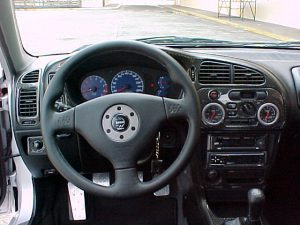Group N cars
These cars have to be based on production models that have been built in numbers greater than 5000 units in order to get homologated. The GroupN cars are sometimes called production cars because they’re supposed to be as close as possible to everyday, street cars. In fact the regulations are a bit vague and top GroupN cars have little in common with their street going counterparts. FIA regulations allow the following modifications to a Group N car:
- Modified front and rear suspension elements (dampers, springs) but geometry has to be maintained
- Modified exhaust system, the catalytic converter has to be maintained
- Modified engine management
More interestingly here’s what you are not allowed to modify in a Group N car:
- Braking system the brake pads and hoses are free
- Engine internals
- Suspension layout and geometry (parts such as shocks and springs can be replaced as well as ride height)
- Gearbox and gear ratios, the gears themselves can be replaced
- Differentials
- Final drive ratio
Note that these rules are subject to revision and changes relatively frequently. For more information please refer to the FIA complete guide to the allowed Group N modifications here (Adobe Acrobat file).
Unfortunately the FIA Group N is almost abandoned by the ruling authority. The above restrictions to the applicable modifications allowed in a GroupN car are subject to interpretation. The quality of a GroupN car can vary according to the owner’s budget. For instance most winning GroupN cars are built from scratch using re-soldered seam-welded, works bodies (very expensive) whereas more affordable ones use normal everyday bodyshells. It is not rare to see GroupN cars equipped with turbo anti-lag systems even if the homologation cars are not equipped with one. Some GroupN cars are reputed more powerful than their Group A counterparts…Worst even, it’s not unusual to see GroupN car retiring from rallies with broken transmissions. I think that says it all. Overall the FIA GroupN is a hybrid between what GroupN was meant to be and the FIA Group A.
To clarify the situation the FIA decided to modify the rules applicable to GroupN cars as of 2001. The major changes include:
- Gearbox and gear ratios can be changed for stronger, possibly dog-style engagement ones (i.e. not using synchromeshes)
- The dimensions of the brakes can be increased and calipers can be changed for multi pot ones
- The transmission final drive ratios can be altered
- Suspension geometry can vary and attachment point on the chassis can be relocated within 20mm
- The rear sits can, finally, be removed
With the above changes the FIA is trying to close the gap between Group A and Group N cars. Unfortunately this move also skyrockets the price of a Group N car and very few competitors will now be able to afford competitive cars in this class. I personally think it would have been wiser to impose stricter controls on current GroupN and make sure they are as close to what is available in dealer showrooms  rather than making the rules more liberal. A huge performance limiting factor would be to impose the use of  OEM tire choices, this would bring costs down to reasonable levels and would be a de facto limit on power.
FIA’s choice, on the other hand, clearly shows that its intention is to lead rallying into an elite sport, a bit like Formula1. This is, of course, conflicting with the sport’s very nature and might well end up in a situation similar to what prevails in endurance racing where alternative organizations manage the races. Time will tell.
GroupN cars are used, mostly, by drivers who either have no extensive rallying experience and wish to learn or drivers who cannot afford the budget related to building a full Group A car (which can cost up to 4 times the price of a GroupN car) not to speak of WRC class cars.
You will find in the following pages a brief history of some the cars involved in the WRC, their characteristics and peculiarities. Rallycars.com also includes up-to-date WRC statistics, current WRC standings as well as WRC driver profiles. I hope you’ll enjoy the ride. If you have any comments or questions please use our feedback page.

